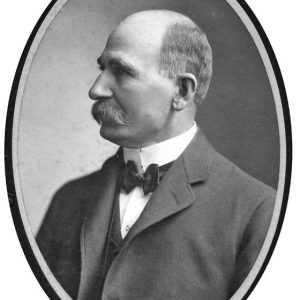calsfoundation@cals.org
William Cary Renfrow (1845–1922)
William Cary Renfrow was an influential political figure during the early territorial years of Oklahoma. A North Carolina native who moved to Arkansas following the Civil War, Renfrow moved to the growing Oklahoma Territory in the late 1880s, where he would play an important role in Oklahoma’s journey toward statehood.
William Cary Renfrow was born on March 15, 1845, in Smithville, North Carolina, to Perry Renfrow and Lucinda Atkinson Renfrow. He got his early schooling there but stopped attending school at the age of sixteen to enlist in the Confederate army. He initially joined Company C in the Fiftieth North Carolina Regiment in February 1862, where he advanced to sergeant. As the war progressed, he transferred to Company F of the Sixteenth Battalion of the North Carolina Cavalry. With the war ending, he was paroled in Goldsboro, North Carolina, in May 1865, and moved to Arkansas with a friend, settling in Russellville (Pope County), where he entered the mercantile trade. He soon got involved in the local community and at one time held municipal office. He and Jennie York married in 1875; they had a son and a daughter.
In 1889, the federal government opened up the Oklahoma land to new settlers, and Oklahoma was soon to be officially declared a territory. Recognizing the potential economic opportunities in the developing region, Renfrow left Arkansas that same year and settled in Norman, Oklahoma, opening a livery stable. It quickly proved very successful, and he was soon able to invest in a bank as well as real estate. In just a short time, he became the majority owner of the Norman State Bank.
A Democrat and an admirer of Grover Cleveland, Renfrow also got involved in Oklahoma politics soon after his arrival. In 1890, Renfrow helped name the county that surrounded Norman after Cleveland. He served as a delegate to the 1892 Democratic National Convention that again nominated Cleveland as the party’s standard bearer. After Cleveland’s victory in the 1892 election, the president, liking both his business background and his residency in the territory, named Renfrow the Oklahoma territorial governor. Renfrow assumed the office in May 1893.
As governor, Renfrow was a devoted advocate of statehood while also seeking to expand the territory. He pushed for the opening of the Cherokee Outlet, which was achieved in September 1893. Equally well received by non-native residents was his successful effort to open the Kickapoo lands, a campaign that came to fruition in 1895. In addition, as governor, Renfrow signed the bill that created Northwestern Oklahoma State University, and he also approved the establishment of the Oklahoma Historical Society. With education a top priority, Renfrow arranged to lease unused school land in an effort to raise money to further public education. He was generally a supporter of the Democratic Party’s anti-black policies, pocket-vetoing a number of proposals that would improve conditions for Oklahoma’s black population. However, he also worked to secure passage of a number of laws that increased the number of schools for black citizens, and despite party orthodoxy, he offered no opposition to the establishment of the Colored Agricultural and Normal University of Oklahoma Territory (which would become Langston University).
The only Democrat to become governor of the territory, Renfrow served until May 1897, when Republican Cassius Barnes was named by Cleveland’s successor, President William McKinley, to replace him.
Upon leaving office, Renfrow returned to the business world. Relocating to Kansas City, Missouri, he established the Renfrow Mining and Royalty Company, for which he served as president until his death. He was a major shareholder in the Mirindo Oil Company and became actively involved in a number of lead- and zinc-mining ventures in southwestern Missouri and northeastern Oklahoma. Around the turn of the century, he moved back to Oklahoma, settling in the town of Miami, where he lived for the last two decades of his life. In addition, he expanded his business operations to include successful gas and oil ventures in Texas.
Renfrow died on January 31, 1922, of sudden heart failure during a trip to Bentonville (Benton County) to visit his ailing brother. He is buried in Oakland Cemetery in Russellville, alongside his wife, who had died in 1914.
For additional information:
Everett, Diana. “William Cary Renfrow (1845–1922).” Encyclopedia of Oklahoma History and Culture. http://www.okhistory.org/publications/enc/entry.php?entry=RE026 (accessed October 22, 2020).
Fields, Anna Page. “William Cary Renfrow, Oklahoma Territorial Governor.” Pope County Historical Association Quarterly 40 (September 2006): 33–40.
“Is Dead.” Morning Tulsa Daily World, February 1, 1922.
Powell, William S. “William Cary Renfrow.” NCPedia. https://www.ncpedia.org/biography/renfrow-william-cary (accessed October 22, 2020).
William H. Pruden III
Ravenscroft School
 Business, Commerce, and Industry
Business, Commerce, and Industry Politics and Government
Politics and Government William C. Renfrow
William C. Renfrow 




Comments
No comments on this entry yet.